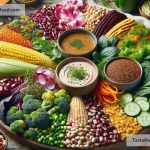Cooking with Foraged Mushrooms for Low-Impact Meals
Cooking more sustainably is something a lot of us aim to do. One of the ways to achieve this is by introducing foraged foods into our meals. And when it comes to foraging, mushrooms are a great place to start. Not only are they delicious but using them in your cooking can help reduce your environmental impact. Here’s your guide to cooking low-impact meals with foraged mushrooms.
What’s So Special About Foraged Mushrooms?
When you pick mushrooms from the wild (assuming you’ve got the know-how or are with an expert), you’re tapping into a natural, renewable food source. Unlike farm-grown veggies that require land clearing, water, and other resources, wild mushrooms ask for none of that. They simply grow in their natural environment, making them a poster child for sustainable eating.
Moreover, foraging for mushrooms gets you outdoors, connecting with nature, and learning about the ecosystem. Plus, it’s a zero-waste approach to sourcing food— you take what you need, and there’s no packaging involved.
Getting Started: Safety First!
Before you head out into the wild with a basket and a mushroom guide in hand, know this: some mushrooms are not just inedible; they’re downright dangerous. It’s crucial to go foraging with someone experienced or to have a comprehensive guidebook (or app) to help you identify which mushrooms are safe to eat.
Many communities have foraging groups or workshops led by knowledgeable experts. Joining one can be a great way to learn. Besides, foraging with others is fun!
Cooking with Foraged Mushrooms
Once you’ve gathered your safe-to-eat mushrooms, it’s time to cook them. The beauty of mushrooms lies in their versatility. They can complement various dishes, from simple stir-fries and soups to sophisticated sauces and risottos. Here are a few ideas to get you started:
Simple Sauteed Mushrooms
The simplest way to enjoy your mushrooms is by sautéing them with a bit of garlic, butter, or olive oil. Add a sprinkle of herbs like thyme or parsley, and you’ve got yourself a delicious side dish or topping for your steak, chicken, or toast.
Mushroom Risotto
Foraged mushrooms make a fantastic addition to creamy risottos. Their earthy flavor elevates the dish, making it taste like something you would get at a high-end restaurant. Plus, making risotto is easier than it seems and is a satisfying way to enjoy the fruits of your foraging labor.
Mushroom Soup
There’s something comforting about a bowl of mushroom soup. Using foraged mushrooms in your soup adds depth and richness that you don’t get with store-bought ones. Blend your cooked mushrooms with broth, onions, garlic, and cream for a simple yet luxurious soup.
Tips for Foraged Mushroom Cooks
-
Clean Gently: Foraged mushrooms can come with a bit of the forest still attached. Clean them gently with a brush or a damp cloth. Avoid washing them under running water as they can absorb it and become soggy.
-
Cook Thoroughly: Wild mushrooms should always be cooked thoroughly. This enhances their flavor and ensures they’re safe to eat.
-
Preservation: If you’ve foraged more mushrooms than you can eat, you can dry them or pickle them. Dried mushrooms can last for months and are a fantastic addition to soups and stews.
-
Experiment: Don’t be afraid to experiment with different mushroom types and dishes. Each type of mushroom has its unique flavor, which can add an interesting twist to traditional recipes.
The Bigger Picture
Cooking with foraged mushrooms is more than just a culinary experience; it’s a step towards a more sustainable way of living. By sourcing food in a way that has minimal impact on the environment, you’re contributing to the health of our planet.
Moreover, foraging reconnects us with the natural world, reminding us of the bounties nature offers and the importance of preserving it.
So, next time you’re in a forest or a field, keep an eye out for some edible mushrooms. The delicious dishes you can create with them are just the beginning of what’s possible when you bring a little part of the wild into your kitchen.
Happy foraging and cooking!


